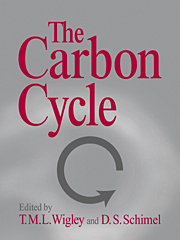Book contents
- Frontmatter
- Contents
- Preface
- Acknowledgments
- Contributors to the 1993 Global Change Institute
- I INTRODUCTION
- II THE MISSING CARBON SINK
- 3 Carbon Dioxide Emissions from Fossil Fuel Consumption and Cement Manufacture, 1751–1991, and an Estimate of Their Isotopic Composition and Latitudinal Distribution
- 4 Emissions of Carbon from Land-Use Change
- 5 The CO2 Fertilizing Effect: Relevance to the Global Carbon Cycle
- 6 Soils and the Global Carbon Cycle
- 7 Grasslands and the Global Carbon Cycle: Modeling the Effects of Climate Change
- 8 Constraints on the Atmospheric Carbon Budget from Spatial Distributions of CO2
- 9 Estimating Air–Sea Exchanges of CO2 from pCO2 Gradients: Assessment of Uncertainties
- 10 Atmospheric Oxygen Measurements and the Carbon Cycle
- 11 A Strategy for Estimating the Potential Soil Carbon Storage Due to CO2 Fertilization
- III PALEO-CO2 VARIATIONS
- IV MODELING CO2 CHANGES
- Part V Appendixes
- Index
3 - Carbon Dioxide Emissions from Fossil Fuel Consumption and Cement Manufacture, 1751–1991, and an Estimate of Their Isotopic Composition and Latitudinal Distribution
from II - THE MISSING CARBON SINK
Published online by Cambridge University Press: 04 December 2009
- Frontmatter
- Contents
- Preface
- Acknowledgments
- Contributors to the 1993 Global Change Institute
- I INTRODUCTION
- II THE MISSING CARBON SINK
- 3 Carbon Dioxide Emissions from Fossil Fuel Consumption and Cement Manufacture, 1751–1991, and an Estimate of Their Isotopic Composition and Latitudinal Distribution
- 4 Emissions of Carbon from Land-Use Change
- 5 The CO2 Fertilizing Effect: Relevance to the Global Carbon Cycle
- 6 Soils and the Global Carbon Cycle
- 7 Grasslands and the Global Carbon Cycle: Modeling the Effects of Climate Change
- 8 Constraints on the Atmospheric Carbon Budget from Spatial Distributions of CO2
- 9 Estimating Air–Sea Exchanges of CO2 from pCO2 Gradients: Assessment of Uncertainties
- 10 Atmospheric Oxygen Measurements and the Carbon Cycle
- 11 A Strategy for Estimating the Potential Soil Carbon Storage Due to CO2 Fertilization
- III PALEO-CO2 VARIATIONS
- IV MODELING CO2 CHANGES
- Part V Appendixes
- Index
Summary
Abstract
This work briefly discusses four of the current research emphases at Oak Ridge National Laboratory regarding the emission of CO2 from fossil fuel consumption, natural gas flaring, and cement manufacture. These emphases include: (1) updating the 1950 to present time series of CO2 emissions from fossil fuel consumption and cement manufacture, (2) extending this time series back to 1751, (3) gridding the data at 1° × 1° resolution, and (4) estimating the isotopic signature of these emissions.
A latitudinal distribution of carbon emissions is being completed. A southward shift in the major mass of CO2 emissions is occurring from European–North American latitudes toward Central–Southeast Asian latitudes, reflecting the growth of population and industrialization at these lower latitudes.
The carbon isotopic signature of these CO2 emissions has been reexamined. The emissions of the past two decades were approximately 1% lighter than previously estimated.
Introduction
Emissions of CO2 from the consumption of fossil fuels have resulted in an increasing concentration of CO2 in the atmosphere of the Earth. Combined with CO2 releases from changes in land use, these emissions have perturbed the natural cycling of carbon, resulting in the accumulation of CO2 in the atmosphere and concern that this may significantly change the climate of the Earth (Houghton et al., 1990, 1996).
Understanding the changes currently being observed and changes likely to occur in the future requires the best possible information on the flows of carbon in the Earth system.
- Type
- Chapter
- Information
- The Carbon Cycle , pp. 53 - 62Publisher: Cambridge University PressPrint publication year: 2000
- 42
- Cited by



